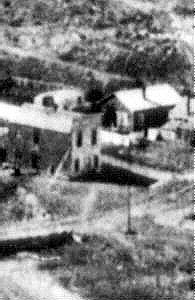Wall Building
1010 Washington Avenue

The Wall Building – 1871
Photo courtesy Golden Historical Collection, Richard A. Ronzio Collection
This is the only photograph known to exist of the first home of the Jefferson County Commissioners. It is a blowup of a tiny section of a panoramic shot taken in 1871, after the Wall Building (at left center of this photo above the primitive Washington Avenue bridge) had been abandoned for some time. It was originally built by brothers David King and John C. Wall in 1859 as their grocery store, selling the first farm produce ever grown in northern Colorado. They proved all the skeptics wrong and laid out their successful irrigated farm at what are now the railyards above Depot Street in eastern Golden, marking the advent of Colorado agriculture as most of the state knew it.
The Wall Building was a two-story false-front frame storefront building standing where the Golden Visitors Center stands today. Unfortunately, John died in 1860, and David gave up farming within a year, and the building went looking for a new use. It found one when Colorado Territory was organized in 1861. In it Jefferson County was reborn, the County’s identity and records kept but its boundaries changed to the present, and provided with a new leadership of three County Commissioners. Wall, along with Wheat Ridge farmer Theodore Perry Boyd and Bergen Park rancher Thomas Cunningham Bergen were the first set of Commissioners ever to hold office. Also elected to office in 1861 were Sheriff Joseph C. Remington, Clerk & Recorder George H. Richardson, Treasurer John M. Ferrell, Assessor James R. Ward, Surveyor Edward Louis Berthoud, Coroner L.W. Lincoln, Probate Judge William Train Muir, County Attorney James B. Wolff, and School Superintendent George West.
Jefferson County was officially reborn November 1, 1861, when the new Territorial government organized it as we now know it. Golden City was affirmed as the county seat. Commissioner Wall offered his own building as the newly reorganized government’s home, where the courtroom and offices were housed for a rent of $27 per month payable in County orders. During the mid-1860s the government returned to the Loveland Building but could not stay away from here for long, converting the building into the first county jail after Mason M. Seavey’s grocery store ceased operating on the ground floor. After that the building remained a derelict until torched by an arsonist in 1876.
by Richard Gardner – Gardner History & Preservation
